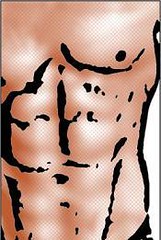This photo has ABSOLUTELY NOTHING to do with Core Stability.
So what is core stability, actually?
Well, some people in the health and fitness industry view this concept a little differently than others. A common misconception is that anything that works your abdominal muscles in creative ways is focusing on "core stability". This is not the case. It bothers me to hear things like "blast that core!" or "get a sexy core" or just today I read "transversus abdominus is not an important abdominal muscle". These things are quite contrary to the thinking of informed physiotherapists, doctors, health & fitness professionals.
The aim of core stabilization training is to effectively recruit the deep trunk musculature while controlling the lumbar spine and pelvis during dynamic movements.
The core trunk muscles: Transversus Abdominis (TA), multifidus (MF), pelvic floor, and by some studies the Internal Oblique (IO) as well. These are key to the active support of the lumbar spine. The co-contraction of these muscles produce stabilizing forces via various systems for the lumbar spine and pelvis.
So the first step is learning how to recruit (activate) these muscles. Co-contraction (recruiting separate muscles together) during certain movements is the next step. Studies have shown that certain patterns exist, such as the co-contraction of the TA and MF muscles occurred prior to any limb movement. This suggests that these muscles anticipate dynamic forces that may act on the lumbar spine and stabilise the area prior to any movement. It follows then, if you can learn to develop this true core stability, then your lumbar spine and pelvis will become more stable during dynamic movements, which results in less excessive forces being transmitted through to these areas.
Area of confusion:
People sometimes see elite athletes doing interesting exercises with all sorts of rotational movement, resistance in the form of elastic bands or medicine balls, and instability from balance boards or swiss balls. They then try to mimic these exercises, realize they are difficult and come to the conclusion that these are great exercises for them to develop their "core". The bottom line is if you are not recruiting the proper muscles (ie:TA, MF or pelvic floor) then you are not developing your true core. You may be doing great rectus abdominus ("6-pack" muscles) or "lat" exercises, but you won't be developing any significant core stability. With proper training, however, you can eventually get to a high level of core stabilty.
harry
Friday, January 26, 2007
Subscribe to:
Posts (Atom)
